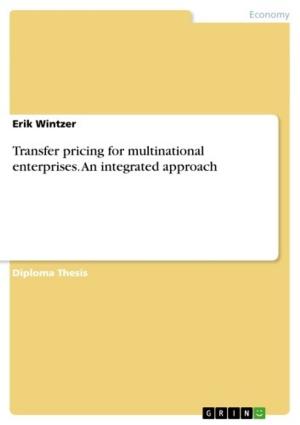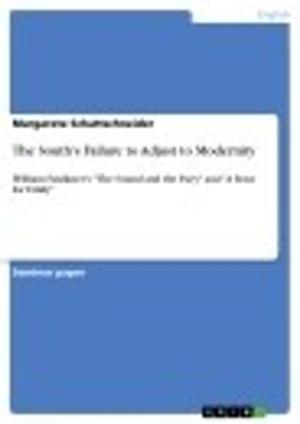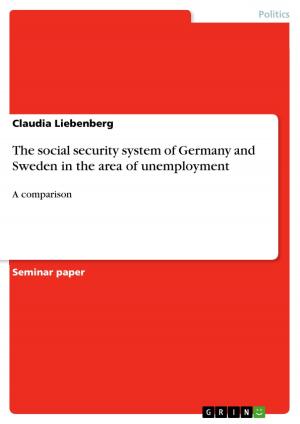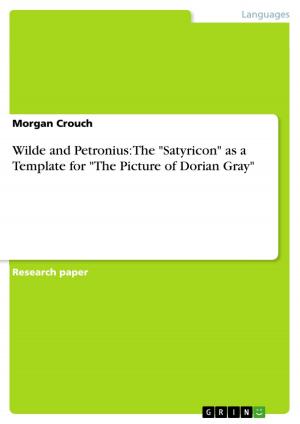| Author: | Miriam Mennen | ISBN: | 9783640568796 |
| Publisher: | GRIN Publishing | Publication: | March 19, 2010 |
| Imprint: | GRIN Publishing | Language: | English |
| Author: | Miriam Mennen |
| ISBN: | 9783640568796 |
| Publisher: | GRIN Publishing |
| Publication: | March 19, 2010 |
| Imprint: | GRIN Publishing |
| Language: | English |
Essay from the year 2005 in the subject Business economics - Marketing, Corporate Communication, CRM, Market Research, Social Media, grade: 72 % - A, University of Sunderland, course: Global Corporate Strategy, language: English, abstract: Ryanair was founded in 1985 as a family business that originally provided full service conventional scheduled airline services between Ireland and the UK. The airline started to compete within the confines of the existing industry by trying to steal customers from their rivals, especially the state monopoly carrier Air Lingus, outlined by Chan Kim and Renée Mauborgne (2004) as 'Bloody or Red Ocean Strategy'. Ryanair seemed to follow a 'me-too strategy'; according to Osborne, K. (2005), they 'tried to be all things to all people'. Even they started restructuring; their strategy was not enough differentiated and their cost advantage was too low to be profitable. Ryanair then created a competitive advantage through the alignment of the three components of business systems; 1)Creating superior value for their customers (outside perspective) 2)Supplying their superior value-adding activities in an effective and efficient manner (which jointly form the 'Value Chain') 3)Possessing over the resource base required to perform the value-adding activities, (inside perspective) According to Porter (1987), 'corporate strategy is what makes the corporate whole add up to more than the sum of its business unit parts.' It is seen to be concerned with the overall purpose and scope of the organisation and to meet the expectations of major stakeholders. All aspects of Ryanair's value chain are important to the company and their shareholders as Ryanair's decisions add value to both. The following report outlines the three perspectives of shaping Ryanair's business system. The value creation dimension of Ryanair's business model will be outlined, considering the theories of Porter and the more recent authors Kim and Mauborgne (2004). Further, the linkages in the airline's value chain and their resource base will be analysed, considering Hamel and Prahalad's (1990) core competency model (inside-out approach). In section 2, the future challenges of the airline are considered. Ryanair's strengths and weaknesses will be analysed, internal value creating factors such as assets, skills or resources, to consider how the airline can create alignment to its opportunities and threats, external factors. An stronger 'outside - in' approach for Ryanair's future corporate strategy will be considered, applying Porter's five forces model, placing the market, the competition, and the customer at the starting point of the strategy process.
Essay from the year 2005 in the subject Business economics - Marketing, Corporate Communication, CRM, Market Research, Social Media, grade: 72 % - A, University of Sunderland, course: Global Corporate Strategy, language: English, abstract: Ryanair was founded in 1985 as a family business that originally provided full service conventional scheduled airline services between Ireland and the UK. The airline started to compete within the confines of the existing industry by trying to steal customers from their rivals, especially the state monopoly carrier Air Lingus, outlined by Chan Kim and Renée Mauborgne (2004) as 'Bloody or Red Ocean Strategy'. Ryanair seemed to follow a 'me-too strategy'; according to Osborne, K. (2005), they 'tried to be all things to all people'. Even they started restructuring; their strategy was not enough differentiated and their cost advantage was too low to be profitable. Ryanair then created a competitive advantage through the alignment of the three components of business systems; 1)Creating superior value for their customers (outside perspective) 2)Supplying their superior value-adding activities in an effective and efficient manner (which jointly form the 'Value Chain') 3)Possessing over the resource base required to perform the value-adding activities, (inside perspective) According to Porter (1987), 'corporate strategy is what makes the corporate whole add up to more than the sum of its business unit parts.' It is seen to be concerned with the overall purpose and scope of the organisation and to meet the expectations of major stakeholders. All aspects of Ryanair's value chain are important to the company and their shareholders as Ryanair's decisions add value to both. The following report outlines the three perspectives of shaping Ryanair's business system. The value creation dimension of Ryanair's business model will be outlined, considering the theories of Porter and the more recent authors Kim and Mauborgne (2004). Further, the linkages in the airline's value chain and their resource base will be analysed, considering Hamel and Prahalad's (1990) core competency model (inside-out approach). In section 2, the future challenges of the airline are considered. Ryanair's strengths and weaknesses will be analysed, internal value creating factors such as assets, skills or resources, to consider how the airline can create alignment to its opportunities and threats, external factors. An stronger 'outside - in' approach for Ryanair's future corporate strategy will be considered, applying Porter's five forces model, placing the market, the competition, and the customer at the starting point of the strategy process.















